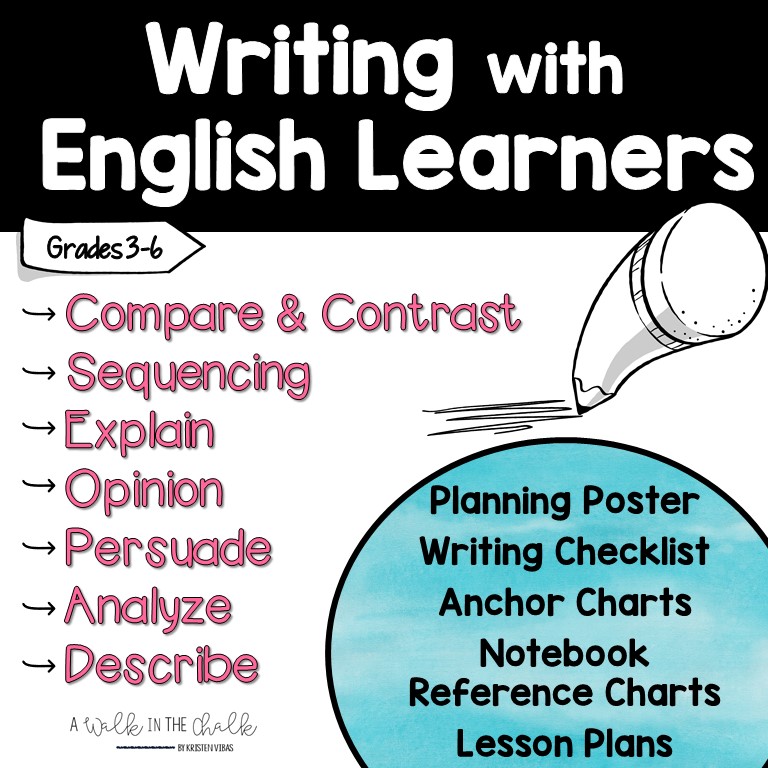How do you instruct your non-English speaking student so that he/she understands AND can actively participate? How can opportunities be provided for your newcomer to engage in the lessons?
1. Visuals, Visuals, Visuals
A picture is worth a thousand words! Boy, this couldn't be more true for a non-English speaker. Visuals are the main form of communication at this stage, and with Google Images at our fingertips, finding just the right visual is easier than ever before. But not just visuals, meaningful visuals. When creating your lessons, think about where you can add visuals to support understanding.
A picture is worth a thousand words! Boy, this couldn't be more true for a non-English speaker. Visuals are the main form of communication at this stage, and with Google Images at our fingertips, finding just the right visual is easier than ever before. But not just visuals, meaningful visuals. When creating your lessons, think about where you can add visuals to support understanding.
Also incorporate visual vocabulary resources that support students during independent work. Word walls with visuals are excellent tools for your newcomers. Word walls that support each content area, even better! Incorporate a "Seasonal Word Wall" as well to provide basic vocabulary exposure for your beginning language learners.
A second grader using his mini-office during independent writing time.
 It's important to build background knowledge prior to each lesson. If your student does not have background knowledge on the topic, it should be provided to him/her as a pre-lesson activity. For example, if the lesson is about the geography of ancient China, create a web or T-Chart with what students already know about the geography of ancient China, or just geography (land). How does that compare with the geography in your newcomer's country?
It's important to build background knowledge prior to each lesson. If your student does not have background knowledge on the topic, it should be provided to him/her as a pre-lesson activity. For example, if the lesson is about the geography of ancient China, create a web or T-Chart with what students already know about the geography of ancient China, or just geography (land). How does that compare with the geography in your newcomer's country?
Front loading essential vocabulary is also very important (remember to support with visuals). Choose a few important words to pre-teach that will support your newcomer's understanding of the lesson.
3. Giving Directions
Directions should be simplified, repeated, and posted visually. Don't ask your newcomer if he/she understands. They will probably nod their head yes, but in actuality will have little to no idea of what's being asked of them.
If you ask your students to get out their "blue reading notebook," hold up an example of what you are asking for so that your newcomer can see what you want.
Speak clearly facing towards your students. If your back or side is facing them, your newcomer will have additional difficulty in understanding.
The "buddy" you've assigned to your newcomer can also assist in helping to get the student started with the assigned activity. This is quick and shouldn't impede from the "buddy" getting started him/herself.
4. Differentiated Materials
Your newcomer will not be able to read the grade level materials provided to the class, so differentiated materials and resources will need to be used. But where do you find them? That's the million dollar question. :) Here are a few suggestions.
Check with the lower grade levels. They have resources that can often be used with newcomers.
Check your school's book room. (Hopefully you have a book room!) If your class is learning about Famous Americans, for example, there may be some low level biographies there that can supplement your classroom materials. Whatever the topic, the book room lower level books are a great resource.
English Explorers books by Benchmark Education are one of my favorite resources. Luckily, in most of the schools I have worked, they have either already had many of these content rich books, or were able to order them. One year I worked at a school that lacked resources, so I wrote a grant and was awarded enough money to purchase several sets. I love these books because they are content specific to the science and social studies standards, and are effectively supported with visuals. AND, they are leveled according to your English language learners proficiency levels! Gotta love that!
English Explorers books by Benchmark Education are one of my favorite resources. Luckily, in most of the schools I have worked, they have either already had many of these content rich books, or were able to order them. One year I worked at a school that lacked resources, so I wrote a grant and was awarded enough money to purchase several sets. I love these books because they are content specific to the science and social studies standards, and are effectively supported with visuals. AND, they are leveled according to your English language learners proficiency levels! Gotta love that!
5. Hands-On Activities
 |
| Salad Science! Students learn about PLANTS and the process of growing their own food, from seed to table. Here students are watering their freshly planted lettuce seeds. |
 |
| Lettuce! |
 |
| Salad Party! The entire 3rd grade enjoyed eating their freshly harvested lettuce and creating a colorful salad! |
This post is a continuation of "Part 1: Environment," found here.
Part 3: Assessments






























No comments